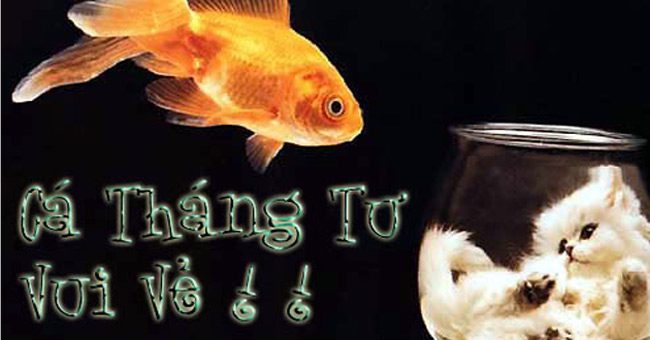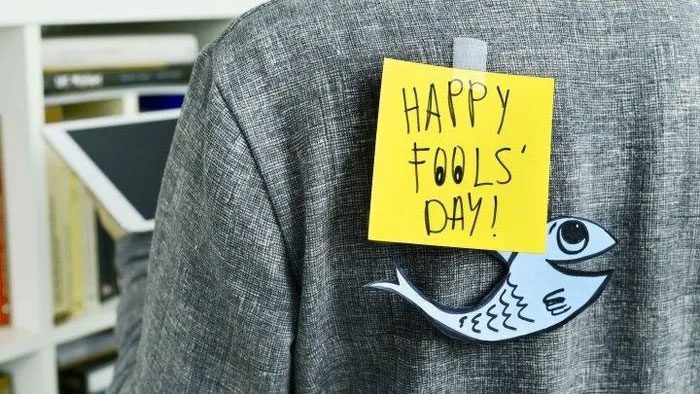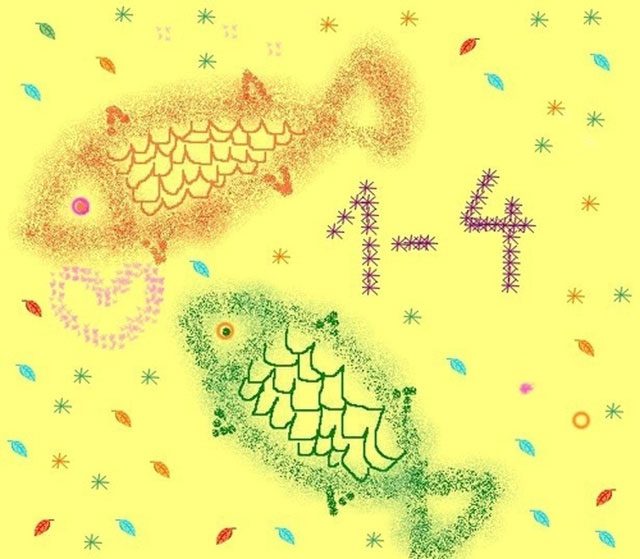Everyone knows that April Fools’ Day is a day for pranks, where people can tease each other without fear of angering anyone. However, the origins, history, and unique customs of this day are less known. Let’s explore and discover the fascinating story behind this day of deception.

Historically, on April Fools’ Day, everyone can boast as much as they want. However, in some places, there are specific timeframes, such as the prank should end by noon. If someone continues to play tricks after noon, they may encounter misfortune.
Although it is widely recognized around the world, the exact origin of April Fools’ Day remains a mystery, with various theories surrounding it. Below is the most commonly referenced story regarding April Fools’ Day.
The Origin of April Fools’ Day
France is considered the birthplace of April Fools’ Day (also known as April 1st Day). In the 16th century in France, the annual festival began on the first day of April. At that time, the new year was celebrated on April 1, as this date was considered the beginning of spring. However, in 1582, King Charles IX ordered the new year to be moved to January 1.

Bringing joy and a relaxed spirit to those around you is the greatest significance of April Fools’ Day.
However, due to the outdated means of communication at that time, news was mainly spread by word of mouth, so not everyone was aware of the change. Some people, knowing the new date, chose to ignore it and continued celebrating the new year on April 1. This stubborn behavior was labeled as “foolish” and became a source of laughter for others.
April Fools’ Day in English is “April Fools’ Day”, where “April fools” refers to the foolishness of April. In French, the home of the day of lies, it is called “poisson d’avril”, meaning “April fish” (poisson – fish). The first mention of this concept was by the French poet d’Amerval. Why? It is believed that d’Amerval used this term because April is the month of Pisces, symbolized by two fish intertwined. It is also the time when fish in temperate waters, like mackerel, are most easily caught as they swim alone. Thus, “April fish” became a term associated with foolishness.
This name originated from a prank where the joker would try to secretly attach a paper fish to the victim’s back without being detected. Consequently, the name “April fish” derives from this.
Images of such fish were also prominent on many postcards in France on April 1 from the late 19th to the early 20th century.

Image of a fish on a postcard in France.
Additionally, we can interpret it as when you tell a lie, you are “baiting,” and those who believe your lie are seen as “fish caught on the hook.” Makes sense, right?
Over time, the pranks on April 1 became a tradition and spread from France to England and Scotland (in the 18th century). The British and the French brought the prank tradition to their colonies in North America. Since then, April Fools’ Day has become an international celebration recognized in many countries.
In Vietnam, this day was also introduced early on, but the Vietnamese refer to it as the day of lies, inadvertently transforming April Fools’ Day, which is meant for jokes, into a day for deceit.
April Fools’ Day holds a beautiful significance as it is a day for everyone to bring joy to one another through harmless lies. These lies can be freely expressed, as long as they do not go too far and the creators of these fibs are not punished.
The Significance of April Fools’ Day
April Fools’ Day is known as a day when people can bring laughter to each other. You can freely play harmless pranks on others.

On April Fools’ Day, you can tease others without fear of them getting angry.
Besides the joy and laughter it brings, in each country, the pranks on April Fools’ Day carry a unique meaning.
April 1 is noted in many countries. Although it is not an official holiday, it is still celebrated in many places through various rumors or jokes about different topics, creating joy or teasing someone.
How Does the World Celebrate April Fools’ Day?
People in each country embrace this tradition in their own ways to prank family and friends.
In Mexico, they celebrate the Day of Lies on December 28. This is a sad moment in the country’s history as it marks the day King Herod ordered the massacre of innocent children. Therefore, the pranks tend to be light-hearted.
In Scotland, there are two April Fools’ Days. The second day is specifically for pranking someone’s backside, known as “Tail-pulling Day.” This is considered the origin of the prank “Kick Me.” Those who are fooled are called “gowk” (fool).

April Fools’ Day in England.
Today, in England, those who are pranked on April 1 are called “April Fools,” which also means fool. A study in the 1950s by folklorists Iona and Peter Opie found that in England and in countries with traditions stemming from the UK, including Australia, pranks typically end by noon. Anyone who plays a prank after noon is considered a “fool.”
The French refer to those who are pranked as Poissons D’Avirl, meaning “April fish.” Perhaps due to the influence of the French, in Vietnam, we also call this day April Fish Day.
In Scotland, April 1 is also referred to as the name of a cuckoo bird – April “Gowks.” The name of April Fools’ Day comes from the prank of trying to sneakily attach a paper fish to the back of the “victim” without being noticed.
Ancient Romans had a festival called Hilaria to honor the god of resurrection, Attis. The name Hilaria sounds very similar to the English word hilarity (funny). The Hilaria festival is still somewhat preserved under the name “Roman Laugh Day.”
In Persia, there is also a holiday with a similar theme known as Sizdahbedar. On this day, which often falls on April 1, Iranians also prank each other with humorous tricks.
Mexico celebrates the Day of Lies on December 28. This is a sad moment in the country’s history as it marks the day King Herod ordered the massacre of innocent children. Therefore, the pranks tend to be light-hearted.
One of the best quotes about April Fools’ Day: Mark Twain, the famous American novelist, had an interesting remark about April Fools’ Day: “April 1st reminds us of our true selves for the remaining 364 days.”
When is April Fools’ Day in 2024?
This year, April Fools’ Day falls on Monday, April 1, 2024.
Classic April Fools’ Day Lies
“Pretending to invite friends or colleagues to eat.”
“Hey, your zipper is down.”
“Come down and open the door for me; I’m standing at your door…”
“I’ll come pick you up; let’s go out together…”
“Breaking the news with ‘two lines’ to that special someone…”
“Sorry, I’m gay.”
“Someone is looking for you down there.”
“Confessing one’s mistakes to parents.”
“Confessing to a crush.”
Why Do We Have April Fools’ Day?
The legend of April Fools’ Day began like this: once upon a time, there was an ancient village a thousand years old, famous for its elegance but also for its love of jokes and tall tales. Not only did the villagers love to joke, but the town officials also enjoyed playful banter. There are classic jokes that remain famous even after thousands of years.
The village elders in that ancient village were not only known for their jokes but also for their playful pranks on the villagers through very practical actions. It seemed that each elder tried their best to come up with delightful pranks that would leave the villagers utterly astonished. One of the most famous incidents occurred back in March of a certain year…

Everyone knows that in that region, the weather in March is quite capricious: sunny in the morning, rainy in the afternoon, humid winds at noon, and freezing the next day… Perhaps it was this unpredictable weather that inspired the elders to come up with a spectacular prank. One dreary March night, as the villagers were snug in their beds, they woke up the next morning in shock to find the trees lining the village road completely stripped bare. The village looked as if a chicken had been hastily plucked. The villagers buzzed with questions: Who chopped down the trees? Why were they cut? Why did no one say anything? What will happen if it rains? Were they sold for money? Or was it the loggers? Or perhaps ghosts? The commotion was relentless.
While everyone was still in disbelief, the elders quickly grabbed a megaphone to announce that this was, in fact, a “super project” to replace the rotting, dying trees. Some curious villagers touched the stumps to investigate, only to be shocked further when they discovered that even healthy trees had been… beautifully chopped down. It turned out that the villagers were the recipients of a delightful prank from their village leaders.
Despite this, the villagers were still pleased to hear the elders say that the replacement trees would be of a rare and special variety: blooming beautifully in spring, even more stunning than Japanese cherry blossoms, with summer flowers as breathtakingly purple as the Jacaranda tree in Australia, and in autumn, vibrant red leaves akin to Canadian maples, while winter would be coldly romantic with the birch trees reminiscent of the former Soviet Union… In general, they promised year-round shade as refreshing as Sapa and Da Lat combined.
Suddenly, the elders brought back a few scraggly trees that looked like sticks, revealing them to be the cheap Ba Chi wood (half fat, half lean). The villagers were left feeling both frustrated and amused (they had to laugh through their disappointment), with some wanting to investigate the costs involved to see if there was anything interesting. To their surprise, this time, there were no more shocking revelations.
Going from one surprise to another, the villagers were amazed by the prankster abilities of their leaders, and they voted the “tree replacement” project as the greatest prank of all time. A few individuals filed complaints with the district chief, who, after reviewing the situation, deemed the elders’ prank excessive. Following a serious reprimand (unlike previous non-serious ones), the villagers agreed that future pranks should be consolidated into a single day for everyone’s well-being, rather than being done haphazardly as before.
Ultimately, everyone agreed to designate April 1 as “Lie Day,” or more commonly known as “April Fool’s Day.” On this day, everyone was allowed to tell lies and play pranks freely, both to enjoy themselves and to commemorate the classic prank that took place throughout that… March.





















































